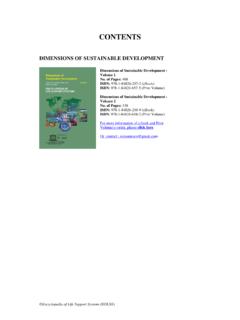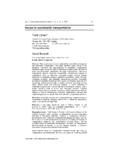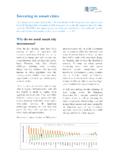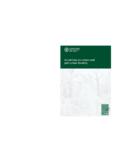Transcription of A Step-by-Step Approach - i-Tree
1 The sustainable urban forest A Step-by-Step Approach Michael Leff Davey Institute / USDA forest Service USFS Philadelphia Field Station Funding and support provided by The USDA forest Service The sustainable urban forest A Step-by-Step Approach Michael Leff September 27, 2016. Davey Institute / USDA forest Service USFS Philadelphia Field Station Acknowledgements I would like to acknowledge the many dozens of people who helped bring The sustainable urban forest to fruition over the past several years. Contributions included general feedback, overall guidance, detailed review, tireless brainstorming, literature research, assorted resources, and a reader's eye as well as moral support and encouragement. Many others served as guinea pigs as we field-tested the guide in various settings. Thank you all for your time and efforts.
2 A special thanks to the Targets & Metrics Team Jim Clark, Joe Gregory, Andy Kenney, and Ed Macie. The team labored intensively, collaboratively, and good-humoredly over a period of more than six months to develop an enhanced and updated version of the urban forest sustainability criteria and indicators, as presented in Part VI Conducting the Evaluation. (The original version of these measures was developed by Jim Clark et al in 1997, and revised by Andy Kenney et al in 2011.) Thanks also to the Morton Arboretum for hosting our team retreat, where we worked through our final revisions in April 2015. Michael Leff August 28, 2016. Davey Institute and USFS Northern Research Station, Philadelphia urban Field Station Contributors: Douglas Airhart, Tennessee Technological University Brain Borkowicz, The Davey Tree Expert Company Cara Boucher, National Association of State Foresters Lindsay Campbell, USFS Northern Research Station, NYC urban Field Station Jim Clark, HortScience, Inc.
3 Chad Clink, The Holden Arboretum Dana Coelho, USFS urban and Community Forestry, Rocky Mountain Region Jan Davis, USFS urban and Community Forestry, Washington office Meaghan Eastwood, Toronto and Region Conservation Authority Alice Ewen, USFS urban and Community Forestry, Washington office Nancy Falxa Sonti, USFS Northern Research Station, NYC urban Field Station Burney Fischer, Indiana University Kevin Frediani, Bicton College (UK). Jason Fristensky, USFS Northern Research Station, Philadelphia Field Station Mike Galvin, SavATree Katie Gibbons, Seattle ReLeaf Joe Gregory, Davey Resource Group Jenny Gulick, Davey Resource Group Alan Halter, City of Austin Jason Henning, Davey Institute and USFS Northern Research Station, Philadelphia urban Field Station Jennifer Hinrichs, sustainable urban Forests Coalition Dana Karcher, Arbor Day Foundation Andy Kenney, University of Toronto Michelle Kondo, USFS Northern Research Station, Philadelphia urban Field Station Larry Kotchman, National Association of State Foresters Beth Larry, USFS Research and Development Monica Lear, USFS Research and Development Dexter Locke, Clark University Pamela Louks, IN2 Trees, Indiana Sarah Low, USFS Northern Research Station.
4 Philadelphia urban Field Station Ed Macie, USFS Southern Region Scott Maco, Davey Institute Charlie Marcus, urban Forester, Tallahassee Lauren Marshall, USFS urban and Community Forestry, Washington office Kyle Meister, SCS Global Services John Melvin, CAL FIRE. Peggy Middaugh, Worcester Tree Initiative Dave Nowak, USFS Northern Research Station, SUNY Syracuse Thomas Omolo, USFS Northern Research Station, Philadelphia urban Field Station Jarlath O'Neil Dunne, University of Vermont Chris Peiffer, Plan-it Geo Michael Rains, USFS Northern Research Station Phillip Rodbell, USFS Northeastern Area Kenton Rogers, Treeconomics (UK). Lara Roman, USFS Northern Research Station, Philadelphia urban Field Station Keith Sacre, Barcham Trees (UK). Lydia Scott, Morton Arboretum Becky Schwartz, Casey Trees Lacey Shaver, STAR Communities Nancy Stremple, National urban and Community Forestry Advisory Council (NUCFAC).
5 Bill Toomey, The Nature Conservancy Larry Wiseman, sustainable urban Forests Coalition Kathleen Wolf, University of Washington and USFS Pacific Northwest Research Station This project was made possible by funding from the USDA forest Service Northern Research Station and a cooperative partnership with The Davey Tree Expert Company. Cover photo credit: To comment on this report, email or call 330-673-9511. Table of Contents Table of Contents Part I Exploring the urban forest .. 1. Overview .. 1. Vibrant Cities and urban Forests .. 1. Sidebar: Recommendations from Vibrant Cities and urban Forests: A National Call to Action .. 2. How to Use This Guide .. 2. Part II Setting the Stage .. 4. What Is a sustainable urban forest ?.. 4. Sidebar: Sample Sustainability Initiatives .. 4. Sidebar: What Is a sustainable Community?
6 5. Understanding Tree Benefits or Ecosystem Services .. 6. Sidebar: What Are Ecosystem Services? .. 7. Sidebar: Estimating Ecosystem Services with i-Tree Design .. 8. Green Infrastructure in the urban forest .. 8. Sidebar: What Is Green Infrastructure? .. 8. Sidebar: Trees as Green Stormwater Infrastructure (GSI) BMPs .. 10. Refining Your 10. Part III Covering the Canopy .. 12. Why Consider Canopy Cover? .. 12. Sidebar: What Is Tree Canopy'? .. 12. What Is an Optimal Canopy Cover Level'? .. 12. Sidebar: Tree Canopy Cover Levels and Goals for Selected Cities .. 13. Sidebar: Search for urban forest Data .. 15. Setting Your Canopy Cover Goals .. 15. Pursuing Your Canopy Cover Goals .. 16. Part IV Gathering the Information .. 19. Taking Stock .. 19. Sidebar: Key Ingredients .. 20. forest Resource Assessments.
7 21. Bottom-Up: Field-Based Assessments .. 21. Complete 22. Sample-based 22. Sidebar: Tree Inventories and Routine Management Software .. 22. Top-Down: Tree Canopy 23. National Land Cover Database (NLCD) satellite imagery .. 23. Aerial photo 23. High-resolution aerial or satellite imagery .. 25. Plans, Practices, Programs, Policies and 26. Part V Constructing the Community Framework .. 28. Sidebar: We cannot separate sustainable urban forests from the people .. 28. sustainable urban forest Guide Page i Table of Contents Why Collaborate?.. 28. Sidebar: Independent action is inadequate .. 28. Sidebar: Possible Stakeholders and Collaborators to Consider .. 30. Internal Municipal Stakeholders and Relationships .. 32. Sidebar: Planning for Trees .. 33. Cross-Sector Stakeholders .. 34. Sidebar: Regulations for Trees at Development Sites.
8 35. Sidebar: General Principle 3: Seek out Private and Civic Partners .. 37. Sidebar: Citizen Foresters in Clovis .. 38. Environmental Justice in the urban forest .. 38. Sidebar: Ensuring Equitable Distribution of Resources .. 39. Tools and Strategies for Engaging the Community .. 40. STEW-MAP .. 40. i-Tree Landscape .. 40. Sidebar: Communicating Your Message: Trees Are the Key Online Toolkit .. 41. Regional Collaboration: Developing a Strategy across Borders .. 42. Chicago Region Trees Initiative for the Seven-County Metropolitan Area .. 42. Sacramento Greenprint .. 44. Sidebar: Greenprint Goals for Growth .. 45. Wisconsin Statewide urban forest Strategy .. 45. Sidebar: Working Well in Wisconsin .. 46. Part VI Conducting the Evaluation: Measuring Success .. 47. Aim for These Targets .. 47.
9 Trees and forest .. 50. Target T1: Relative Tree Canopy Cover .. 50. Target T2: Age Diversity (size class distribution) .. 51. Target T3: Species Diversity .. 53. Target T4: Species 54. Target T5: Publicly Owned Trees (trees managed intensively ).. 55. Target T6: Publicly Owned Natural Areas (trees managed extensively ).. 56. Target T7: Trees on private property .. 57. Community Framework .. 58. Target C1: Municipal agency cooperation .. 58. Target C2: Utilities Cooperation .. 59. Target C3: Green Industry Cooperation .. 60. Target C4: Involvement of Large Private and Institutional Landholders .. 61. Target C5: Citizen Involvement and Neighborhood Action .. 62. Target C6: General Appreciation of Trees as a Community Resource .. 63. Target C7: Regional Collaboration .. 64. Resource Management Approach .
10 65. Target R1: Tree Inventory .. 65. Target R2: Canopy Cover Assessment and Goals .. 66. Target R3: Environmental Justice and Equity .. 67. Target R4: Municipality-Wide urban forest Management Plan .. 68. Target R5: Municipality-wide urban Forestry Funding .. 69. sustainable urban forest Guide Page ii Table of Contents Target R6: Municipal urban Forestry Program Capacity .. 70. Target R7: Tree Establishment Planning and 72. Target R8: Growing Site Suitability .. 73. Target R9: Tree Protection Policy Development and Enforcement .. 74. Target R10: Maintenance of Publicly Owned, Intensively Managed Trees .. 75. Target R11: Management of Publicly Owned Natural 76. Target R12: Tree Risk Management .. 77. Target R13: urban Wood and Green Waste Utilization .. 78. Target R14: Native Vegetation .. 79.









